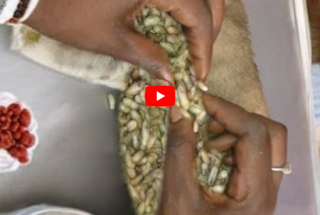
Mango worms—also known as tumbu fly larvae—are a type of parasitic infestation commonly found in certain regions of Africa. For dog owners living in, visiting, or adopting animals from these areas, the possibility of mango worm infection can be a serious concern. Understanding how these worms infect dogs, the early signs to watch for, and the correct steps to take at home can help reduce discomfort and prevent complications.
This article provides a clear, practical guide on identifying mango worm infections in dogs, what to do at home, and when it’s essential to seek veterinary care.
What Are Mango Worms?
Mango worms are the larvae of the tumbu fly (Cordylobia anthropophaga). The adult fly lays its eggs in soil, sand, clothing, bedding, or anywhere that retains moisture. When a dog lies on contaminated surfaces, the warmth of the skin triggers the eggs to hatch. The larvae then burrow into the dog’s skin, where they develop over several days.
Because the eggs are microscopic, pet owners often have no idea that exposure has occurred until symptoms appear.
How Dogs Get Infected
A dog does not need to be dirty or neglected to contract mango worms. Common sources of exposure include:
- Sleeping or lying on soil where the fly has laid eggs
- Contact with contaminated bedding or clothing left outdoors
- Rolling in damp sand or mud
- Exposure during travel or relocation from endemic areas
Dogs who spend time outdoors or live in warm, humid climates are at higher risk.
Symptoms of Mango Worm Infection
Mango worm infections are usually easy to identify once the larvae grow. Key symptoms include:
1. Small, raised skin bumps
These bumps often resemble pimples, boils, or white-topped swelling.
2. Itching or irritation
Dogs may scratch, lick, or chew at the affected area.
3. Pain when touched
The lumps can be tender, causing the dog to pull away when the area is pressed.
4. Tiny holes in the skin
These breathing holes may leak a clear or slightly yellow fluid.
5. Clusters of lesions
Multiple larvae can infest the same region, especially on the belly, legs, and back.
While these symptoms can be alarming, mango worm infestations are treatable. The key is acting quickly and handling the situation safely.
What You Can Do at Home
While some steps can be taken at home, it’s important to be cautious. Improper removal can injure your dog or cause infection. Here are safe and responsible guidelines:
1. Keep the Area Clean
Gently clean around the bumps with warm water and mild soap. This helps prevent secondary bacterial infections.
2. Apply Warm Compresses
A clean warm compress can help soothe discomfort and soften the skin. This does not remove the larvae but may help reduce inflammation.
3. Prevent Scratching
Use an Elizabethan collar if necessary to stop your dog from breaking the skin, which can lead to infection.
4. Monitor for Worsening Symptoms
Look out for:
- Increased swelling
- Foul odor
- Pus
- Lethargy
- Fever
These may indicate infection and require urgent veterinary care.
Why Proper Larva Removal Should Be Done by a Veterinarian
Although some online sources show home removal methods, attempting to extract mango worms yourself is not recommended. The risks include:
- Incomplete removal (leaving part of the larva can cause severe infection)
- Painful skin trauma
- Internal tissue damage
- Secondary bacterial infection
- Unnecessary suffering
A veterinarian has the proper tools, sterilization equipment, and expertise to remove the larvae safely and cleanly.
If professional help is accessible, it is always the best option.
Home Care After Veterinary Removal
Once your dog receives proper treatment, aftercare at home is simple and helps ensure a smooth recovery:
1. Keep the Wound Clean
Follow your vet’s cleaning instructions, often involving mild antiseptic solutions.
2. Administer Medications
This may include:
- Antibiotics
- Pain relief
- Anti-inflammatory medication
Give the full course as prescribed.
3. Prevent Re-Injury
Keep your dog from licking or scratching the healing area.
4. Watch for Signs of Complications
If you notice spreading redness, swelling, heat, or fever, contact your vet immediately.
How to Prevent Mango Worms in Dogs
Prevention is always easier than treatment. Key strategies include:
1. Keep Bedding Clean and Indoors
Avoid drying dog bedding or clothing outside in areas where tumbu flies are common.
2. Avoid Letting Your Dog Lie on Bare Soil
Provide a clean mat or raised bed, especially outdoors.
3. Regular Grooming and Skin Checks
Check for bumps, especially after outdoor play.
4. Use Preventive Sprays When Recommended
Your veterinarian may suggest repellents in high-risk regions.
5. Maintain a Clean Environment
Remove waste, stagnant water, and damp debris that may attract flies.
Final Thoughts
Mango worm infestations can be distressing, but with quick action and proper care, dogs recover well. Identifying symptoms early, keeping your dog comfortable, and seeking veterinary assistance are the most important steps. Safe at-home practices can help manage discomfort and support healing, but removal should always be done professionally.



